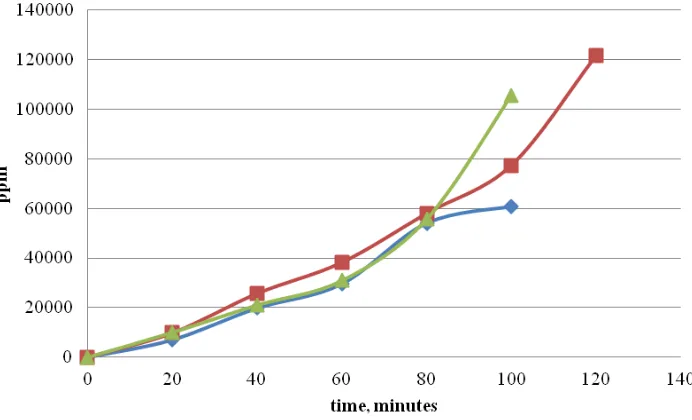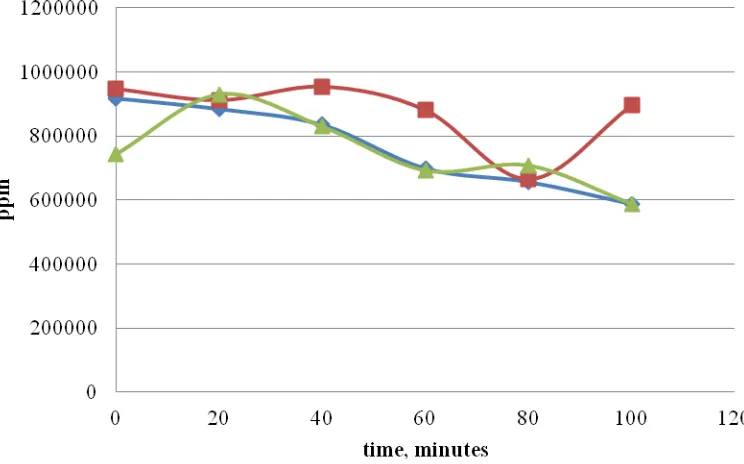Journal of Chemical and Pharmaceutical Research, 2015, 7(9S):17-21
Research Article
CODEN(USA) : JCPRC5
ISSN : 0975-7384
Synthesis of biodiesel from waste cooking oil by two steps process
transesterification and ozonation
Lieke Riadi
a,b*,
Aloysius Yuli Widianto
a, Edy Purwanto
a, Akso Pono
aand Ruth Theresia
aaChemical Engineering Department, The University of Surabaya, Jl. Raya Kalirungkut. Surabaya, Indonesia bCenter For Environmental Studies, The University of Surabaya, Jl.Raya Kalirungkut. Surabaya, Indonesia _____________________________________________________________________________________________
ABSTRACT
The synthesis of biodiesel has been widely studied. There are many raw materials used for the synthesis either from edible or non-edible oil. In this study, we investigated the synthesis of biodiesel using two steps process. The synthesis at 60 oC and ozonation are running in consecutive ways. The waste cooking oil was prepared for synthesis at 60 oC for one hour. The mol ratio of waste cooking oil and methanol was 1:5 and 1.5 % w/w NaOH was used as catalyst. Sample from both synthesis at 60 oC and ozonation process have been analyzed using Gas Chromatography. It has been proved that transesterification product from synthesis at 60oC contained of long chain methyl esters, hence the reaction is esterification from long chain fatty acids to long chain methyl esters which consisted of saturated and unsaturated methyl esters. The dominants long chain methyl esters from synthesis at 60
oC were methyl palmitate, methyl oleat, methyl stearate. There were three unsaturated methyl esters produced which
are methyl palmitoleate, methyl oleat and methyl linoleate. All these products were then ozonised at various temperatures. Short chain methyl esters which were from cracking of unsaturated methyl esters and long chain methyl esters remained as product. The short chain methyl esters are methyl nonanoate, methyl hexanoate, and methyl octanoate. Methyl nonanoate was a product from cracking of methyl oleate, whereas methyl hexanoate was a product of cracking of methyl linoleate .It was found that the best temperature used for ozonation was 20 oC.
Keywords: transesterification, ozonolysis, long chain methyl esters, short chain methyl esters, two steps process.
_____________________________________________________________________________________________
INTRODUCTION
agent, and known to react with double bonds in fatty acids to form intermediate products yield aldehydes, acetal and then formed methyl esters.
EXPERIMENTAL SECTION
Materials
Waste cooking oil from fast food restaurants, Methanol 96 %, Potassium iodide, Magnesium sulphate anhydrate, Potassium Hydroxide and Sodium Carbonate were supplied from Merck, Oxygen gas was purchase from Aneka Gas Industry.
Experiment
Synthesis at 60 oC (Transesterification)
Waste cooking oil and methanol with mol ratio 1 : 5 were poured into 2 L glass reactor equipped with a cooling system, stirrer, tube sparger and thermocouple. A 1.5 weight % of NaOH was added to the reactor. The experiment was run for 1 hour at 60 oC with agitation speed of 450 rpm. After one hour of experiment, sample was treated for separation between biodiesel and methanol, purified by removing water. Sample was then analysed for methyl esters and intermediates using GC (Gas Chromatography).
Ozonation
The product resulted from synthesis at 60 oC was mixed with methanol with mol ratio of 1:7 and poured in a 2 L stainless steel reactor equipped with a cooling system, stirrer, tube sparger and thermocouple. Each of 1.5 % and 2 % weight of sulfuric acid were added as catalyst. Ozone was produced from oxygen gas using VIRESCO ozone generator (Singapore). The ozone concentration in the feed was maintained about 5.8 mol % at certain flow rate. The reactor outlet was connected to a potassium iodide solution trap hence excess ozone was decomposed. The reaction was run at 20 oC, 450 rpm agitation. Samples were taken every 20 minutes. After the reaction run for 2 hours, the ozone gas was shut off, the reaction products in the reactor were flushed for 10 minutes with oxygen to remove the excess of ozone.. Each sample taken was separated using funnel filter to get the biodiesel. The biodiesel was then washed with warm water to remove catalyst and also side product. Water remained in the product was removed by MgSO4, anhydrate, and the biodiesel was analyzed using GC (Gas Chromatography).
Assays
Gas Chromatography analysis: Analysis of all standards and samples were performed with a HP GC instruments with Carbowax column (30 m length 250 µ m internal diameter, 0.25 µm thickness) and a flame ionization detector. Helium gas was the carrier and used at flow rate of 0.6 ml/min. The column temperature programming conditions were as follows: temperature was initially set at 60 oC for 2 minutes, increased to 200 oC at rate of 10 oC/min and hold for 4 minutes, it is then raised to 240 oC at rate 5 oC/min and hold for 7 minutes. Temperatures of the injector and detector were 275 oC and 200 oC respectively. Split injection was used at a sample size of 1.0 µl.
RESULTS AND DISCUSSION
Biodiesel Synthesis at 60 oC
Waste cooking oils used in this experiment consisted of unsaturated and saturated fatty acids. The biodiesel synthesis at 60 oC (transesterification) was designed to synthesis fatty acids and form methyl esters. Methyl esters formed from the experiment is presented in Table 1. The dominant methyl esters resulted from the synthesis were methyl palmitate, oleat and stearate. It is similar with the composition of waste cooking oil which is dominated by palmitic, stearic and oleic acids. There were two unsaturated methyl esters produced from this process, methyl oleate and methyl linoleate. The saturated methyl esters produced form this process were methyl laurate, methyl myristate, methyl palmitate, methyl heptadecanoate, methyl stearate, methyl arichidate. The unsaturated methyl esters produced was 34.33%, whereas the saturated methyl esters produced was 65.67 % This result showed that transesterification process produced methyl esters without intermediates.
Table 1. Methyl esters from synthesis at 60 oC (transesterification)
Unsaturated Methyl esters Saturated Methyl esters mg/L
Ozonation Process
Methyl esters resulted from synthesis at 60 oC were then used for ozonation experiment at 10 oC,20 oC and 30 oC .Moreover, the short chain methyl esters were produced as double bond was attacked from unsaturated methyl esters by ozone. They are methyl hexanoate, methyl octanoate and methyl nonanoate. Other fragments from cracking process was predicted as dimethyl azelate and dimethyl malonate as can be seen at Table 2. (Baber et.al, 2005).
Table 2. Fragments produced from cracking of unsaturated methyl esters
Unsaturated Methyl esters Fragments of short chain methyl esters & dimethyl esters Methyl oleate (C 18:1) Methyl nonanoate Dimethyl azelate
Methyl linoleate (C18:2) Dimethyl malonate Methyl hexanoate Dimethyl azelate
Methyl octanoate was assumed a synthesis from methyl linolenate (Frankel et.al, 1987), however methyl linolenate was not detected by GC, although it was a component as fatty acid in waste cooking oils which has been considered as others (2.17 %). Short Chain Methyl Esters was continually produced during the ozonation, however long chain methyl esters which have been formed during transesterification were decrease during ozonation. This result will be explained in section 2.3.
Effect of temperature in Ozonation Process
The total short chain methyl esters (SCMEs) produced from ozonation increased with time of reaction, both for 1.5 % and 2 % acid catalyst as can be seen at Figure 1 and 2. The highest value of total short chain methyl esters was at 20 oC. However, the total long chain methyl esters (LCMEs) were decreased during ozonation process as can be seen at Figure 3 and 4. It is proved that ozonation process consisted of transesterification and ozonolysis. The transesterification occurs as a simultaneous reaction with ozonolysis though the experiments were carried out at 10
oC, 20 oC and 30 oC. We assumed that the decrease of long chain methyl esters was due to reverse reaction as a
result of backwards reaction of transesterification (Pahola, et.al, 2013). Hence, we need to stop the ozonation process prior 2 hours completion of experiment.
Figure 1. Total SCME at different temperature ozonation (∆ 30 oC,
□20 oC,
◊10 oC), 1.5 % acid catalyst
Figure 2. Total SCME at different temperature ozonation (∆ 30 oC,
□20 oC,
◊10 oC), 2 % acid catalyst
Figure 3. Total LCME at different temperature ozonation (∆ 30 oC,
□20 oC,
◊10 oC), 1.5 % acid catalyst
Table 3. The Kinematic viscosity of the product at different temperature
Kinematic viscosity Temperature
10 oC 20 oC 30 oC
Figure 4. Total LCME at different temperature ozonation (∆ 30 oC,
□20 oC,
◊10 oC), 2 % acid catalyst
CONCLUSION
The best operation condition for ozonation after transesterification (60 oC) was at 20 oC using either 1.5 % or 2 % catalyst. To avoid losses of Long chain methyl esters, the ozonation process is suggested to stop at 40 minutes of experiment. Short chain methyl esters and dimethyl esters have been produced as fragments from doubled bond cracking of unsaturated methyl esters due to the ozonolysis. There were losses of long chain methyl esters which have been produced for the step process due to reverse reaction of transesterification in the ozonation process.
Acknowledgements
This study was carried out with the aid of a research grant from Indonesia Directorate General for Higher Education.
REFERENCES
[1] Baber, T.M, Gravier, D, Lira, CT and Narayan, R. Biomacromolecules, 2005, 1334-1344. [2] Demirbas, A. Energy Conversion and Management, 2009, 50, 14-34.
[3] Frankel, E.N., Neff, W.E. , Selke E. and Brooks, D.D. LIPIDS, 1987, Vol. 22, No. 5, 322-326.



